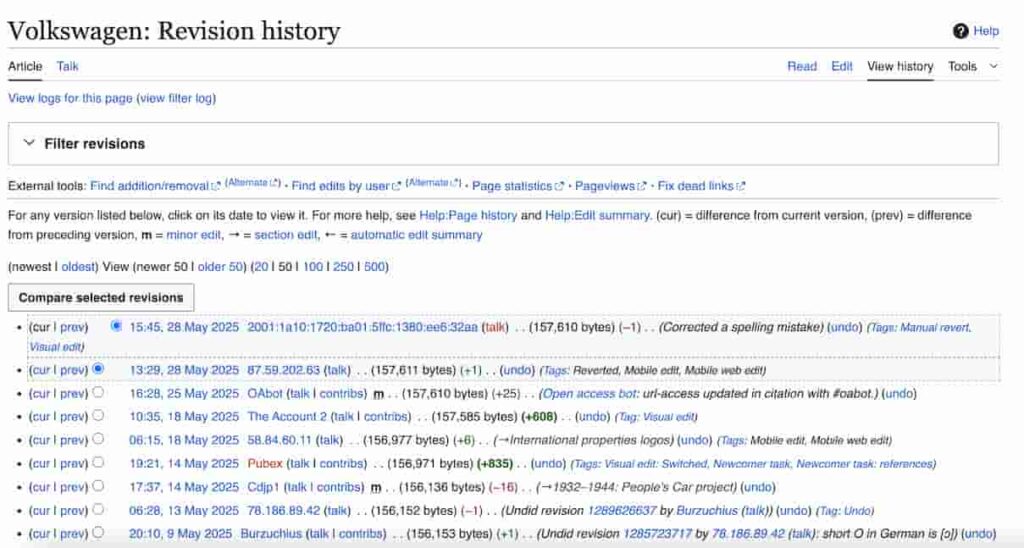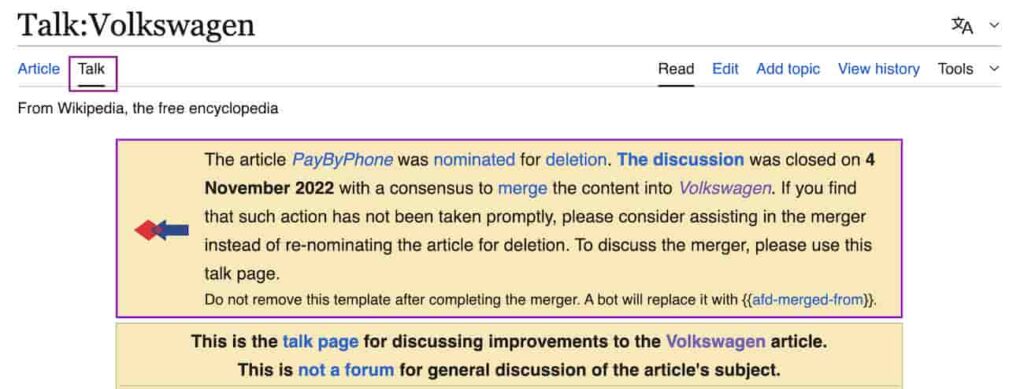How to Maintain and Protect Your Shiny New Wikipedia Page

Creating a Wikipedia page sometimes feels like building a sandcastle at low tide: impressive at the time, but vulnerable when the water rises. You might think the hard part is behind you once someone has gotten your page up and running (clearly, you don’t want to do it yourself). But without Wikipedia maintenance—an edit dispute, unnoticed warnings, or policy changes—you could find yourself scrambling to get someone to protect it from being swept away.
Remember that if your Wikipedia page is vandalized or deleted, it affects your search engine results, especially since Wikipedia ranks in the top 3 search results for over 50% of all Google queries, and up to 99% in some cases.
Maintaining your Wikipedia page effectively is more than simply avoiding deletion. It’s about keeping it accurate, respected, and beneficial to readers. Wikipedia’s policies shift and evolve, with nuances that can trip you up even if your initial publication sailed through smoothly. But rest assured, there are clear strategies that can be applied. The following checklist provides practical advice to keep your page compliant, credible, and secure in the long haul.
By this point, you’ve navigated the complexities of starting the page. Now let’s look at what it takes to nurture it, keeping it alive, relevant, and intact—step by step.
Main Points
- Build a foundation: Research Wikipedia policies, particularly those related to neutrality and reliable sourcing. If you’re confident your article aligns with these guidelines (and you are right), your page will weather challenges smoothly.
- Consistently monitor edits: Staying alert to changes can mean quickly asking editors to correct misinformation or catching malicious edits before they cause damage.
- Engage calmly on Talk Pages: Using the Talk pages proactively can resolve conflicts early and encourage more collaborative editing.
- Use highly reputable sources: This is really important! Good sourcing directly impacts the durability and credibility of your page. Make sure anyone editing your page will stick to respected, independent sources.
- Quickly address warning flags: Treat alerts seriously. Prompt action on issues—like insufficient sourcing or unintentional bias—is often all it takes to avoid escalation.
- Avoid promotional tone: Wikipedia is not marketing collateral; neutrality is non-negotiable. Stay strictly factual to maintain a good standing on your page.
- Commit to ongoing maintenance: Set aside regular time to review your page. Making regular, incremental updates establishes your page’s authority.
- Prevention beats recovery every time: It’s far easier to avoid deletion threats upfront than trying to reverse them later. Know the deletion process well, just in case.
Let’s examine how to put these strategies to work, keeping your Wikipedia page both credible and resilient.
Ensure Compliance with Wikipedia Guidelines
Wikipedia sets clear, if slightly complex, guidelines for maintaining an article. Compliance helps your page stay visible, respected, and free from significant editorial conflicts. Let’s discuss some actionable practices.
Cite Reliable and Reputable Sources
Quality sourcing is a top safeguard against page deletion. Wikipedia favors established, reputable sources such as recognized national newspapers, academic journals, or respected industry publications. Avoid blogs, promotional material, or press releases that editors frequently flag as insufficient.
For example, if your company’s page relies on a niche, unedited blog to support a major claim, Wikipedia editors may quickly challenge it.
Here’s an example of a “better source needed” template commonly used in articles to indicate inline citations that link to insufficiently reliable sources.

If there is a problem within an entire section, an editor may choose to place a template at the top of sections of articles that need additional references. This template is even more obtrusive and difficult to remove.

It is better to get ahead of these templates and use high-quality sources rather than niche or questionable ones. Choosing to cite authoritative sources, think: Gartner Reports or opinion pieces in the Harvard Business Review, reinforces credibility.
Regularly revisit your references and ask someone to update your citations as newer information becomes available. Maintaining fresh, high-quality citations signals that your content and organization remain relevant and trustworthy.
Add Additional Content Over Time
Wikipedia thrives on relevant, continually updated information. Rather than leaving your page static, add well-documented events or achievements periodically. Frequent, modest updates build the page’s notability and prove ongoing relevance.
Suppose your company was just recognized by an established industry award—as long as independent sources document it, that’s an ideal addition. By incrementally building your article, you spread out editorial scrutiny and increase its long-term stability.
Avoid Over-Promotion
Wikipedia explicitly forbids promotional content. Highly flattering phrases like “market-leading” or “unrivaled solutions” immediately flag your page as advertorial and risk swift editing or deletion. If someone adds this to the page, be careful.
Instead, simply get them to state facts neutrally. For instance, writing “the company’s software was adopted by Fortune 500 companies like Microsoft and Cisco in 2021,” supported by respected third-party references, very clearly conveys authority without crossing into promotional territory.
Monitor Page Activity and Edits
Continuous monitoring is part of Wikipedia maintenance. Wikipedia involves open collaboration; not every edit comes from well-intentioned contributors. Here’s how you can effectively keep tabs on it.
Set Up Notifications
A Wikipedia watchlist alerts you instantly to any new edits. Getting started takes seconds: log in, click the star icon in the top-right corner of your page, and edits will appear in your account’s watchlist feed. Enable email notifications for even quicker alerts.
For higher-profile pages, you might consider third-party monitoring tools approved by Wikipedia to help track edits more robustly and reduce manual review.
Regularly Review Edit History
Get familiar with the “View history” tab—you can see every single change ever made. Review edit histories periodically, focusing especially on large-scale deletions or suspicious anonymous edits.
Here’s an example of a Wikipedia page history:

Seeing repeated deletions from one anonymous user? Check more closely—catching these issues early helps you maintain consistent accuracy and prevent damaging edits.
Engage Actively with Talk Pages
The Talk page is where contributors discuss editing disagreements, intentions, and page improvements. Rather than ignoring these conversations, actively participate. Make your points calmly and factually, referencing Wikipedia guidelines where appropriate. You do not have to be an editor to participate on the Talk page.

If another editor suggests removing content for perceptions of bias, politely clarify your reasoning and offer compromises if needed. Finding the middle ground can resolve disputes quickly, keeping your page stable.
Strengthen Page Credibility
Strong credibility actively shields your article from deletion threats and editorial disputes. Building credibility means actively maintaining page content with thoughtful, neutral contributions and ongoing vigilance about sourcing.
Prioritize Reliable Sources
If Wikipedia had cornerstones, reputable and authoritative sources would be undeniable foundations. Stick strictly to independent, widely respected references like peer-reviewed journals, well-known newspapers, established brands, or notable industry reports.
Mentioning major company achievements? Reference a prominent article from Forbes instead of your company’s internal newsletter. Each reliable citation contributes significantly to overall credibility.
Update Content Regularly
A credible Wikipedia page evolves as your organization evolves. Incorporate new product launches, team changes, industry recognition, or expanded operations when they are covered by verifiable independent sources. Keep edits factual and neutral to maintain trust.
Don’t wait until you have massive changes; incremental adjustments demonstrate consistent activity to editors, reducing scrutiny and enhancing authoritative standing.
Maintain a Strict Neutral Tone
Avoid promotional adjectives—write factually instead. Rather than describing your brand as revolutionary or incredible, highlight verified statistics that organically demonstrate your organization’s strengths. Editors quickly remove subjective content and are more likely to flag overly promotional articles for deletion.
Why Wikipedia Pages Get Targeted
Wikipedia is one of the most powerful reputation assets on the internet — and one of the most vulnerable.
Because it ranks so prominently in Google (appearing in the top 3 results for over 50% of search queries), a Wikipedia page isn’t just informational — it’s symbolic. It signals legitimacy, notability, and public interest. That makes it a target.
Whether you’re a CEO, startup founder, nonprofit, or public figure, your Wikipedia page can attract unwanted attention from anonymous editors, trolls, competitors, or even ideological adversaries. Here are 5 main reasons why Wikipedia pages get targeted.
1. Agenda-Driven Edits
Wikipedia is built on the principle of neutrality. But behind the scenes, some editors operate with agendas, such as:
- A competitor might insert negative facts (sourced or not) framed in an unflattering way
- Activists may scrub or alter content to support a narrative
- PR “clean-up” attempts by paid editors can backfire, drawing scrutiny or deletion
Wikipedia can become a battleground for reputation warfare, where the goal is not to tell the truth — but to shape perception through omission, framing, or erasure.
2. Conflict of Interest Flagging
Pages created or edited by people with a direct stake in the subject are often flagged for Conflict of Interest (COI) — even if the edits are accurate.
Once flagged, the article may be scrutinized more closely by admins and volunteer editors, increasing the risk of:
- Tags like “This article reads like an advertisement”
- Content removal
- Deletion proposals
3. Deletion Campaigns and Notability Challenges
In some cases, organized deletion efforts are launched to remove pages, often through Wikipedia’s “Articles for Deletion” (AfD) process.
If editors believe a subject is not notable, meaning there’s insufficient coverage in independent, reliable sources, the article may be deleted, even if the person or organization is prominent in real life.
Common triggers include:
- Too many primary sources or press releases
- Lack of coverage from third-party media
- Old pages with outdated or unverifiable citations
4. Vandalism and Trolling
Wikipedia vandalism, ranging from juvenile jokes to defamatory claims, can be inserted at any time.
Though most high-visibility pages are semi-protected, lesser-known individuals and brands are vulnerable to:
- Swear words and slurs
- Falsified accusations
- Misinformation inserted under the radar
This kind of damage is often indexable by Google within hours, meaning even a brief act of vandalism can leave a reputational scar in search engine results.
5. Symbolic Erasure
Sometimes the most powerful attack isn’t what’s added, it’s what’s removed.
In Wikipedia terms, this might look like:
- Deletion of an article for “non-notability”
- Quiet edits that remove awards, achievements, or positive framing
- Rewriting sections to downplay impact or authority
Prevent Deletion Risks
Even experienced executives can find Wikipedia’s deletion policies a bit tricky. Understanding deletion triggers and swiftly addressing editorial flags are pivotal if you want your page to stay for the long term. Active Wikipedia maintenance can help keep a strong pulse on potential deletion risks.
Top Threats to Your Wikipedia Page
| Threat Type | Description | Defense Strategy |
|---|---|---|
| Vandalism | Malicious edits or defamation | Watchlist + edit filters |
| Biased Editing | Agenda-driven framing | Engage experienced editors |
| Notability Challenges | Article flagged for deletion | Add secondary reliable sources |
| Conflict of Interest Accusations | Conflict of interest tagging | Use Talk page and third-party advocates |
Know Deletion Policies
The two most frequent reasons Wikipedia deletes pages are insufficient notability and weak sourcing. Familiarize yourself with deletion categories such as “speedy deletion” and “proposed deletion” (PROD).

Pages considered borderline notable typically slide by with solid independent references.
Recognizing potential issues early—such as reliance on internal company documentation rather than independent coverage—helps proactively improve the page, reducing the risk of deletion.
Respond Quickly to Flags or Warnings
Act immediately when warnings or flags arise. If an editor adds tags about weak sources or biased content, address the issue right away by improving references or rewriting to a strictly neutral stance.
Engagement here helps resolve the underlying issue quickly, demonstrates responsible editing, and avoids further escalation into formal deletion discussions.
Refer Back to Proven Resources
When in doubt, return to trusted guidelines, such as The Guide to Wikipedia Article Deletion & Maintenance. Clear, accessible advice there reinforces your ability to manage page challenges effectively and confidently.
Regularly Update and Maintain the Page
Good maintenance ensures credibility, reduces deletion risk, and helps your page continuously meet Wikipedia’s standards. Here’s a practical approach to regular updates:
- Schedule periodic audits, preferably quarterly, to ensure accuracy and relevance.
- Adopt page-monitoring tools—like Wikipedia’s built-in watchlist or third-party options—to promptly detect and fix unauthorized edits.
- Consider partnering with Wikipedia specialists for guidance on complex updates or when disputes arise. Experienced editors effortlessly maintain neutrality and policy compliance.
Regular maintenance doesn’t have to be time-consuming. Just setting a routine for incremental improvements shows proactive stewardship and helps maintain a resilient page.
Conclusion
Maintaining a strong Wikipedia page reflects your commitment to transparent communication and integrity. Proper care doesn’t just keep your page visible—it plays a significant role in shaping your organization’s reputation, aligning your public image with reality.
At its core, Wikipedia maintenance comes down to ongoing diligence and thoughtful engagement. It’s a commitment not only to your organization’s representation but also to the truthfulness of collaborative public information. By actively monitoring, updating responsibly, addressing editors’ concerns, and prioritizing neutrality, your hard-earned Wikipedia presence becomes a sustainable element of your brand’s digital trust.
Tags: Wikipedia.
